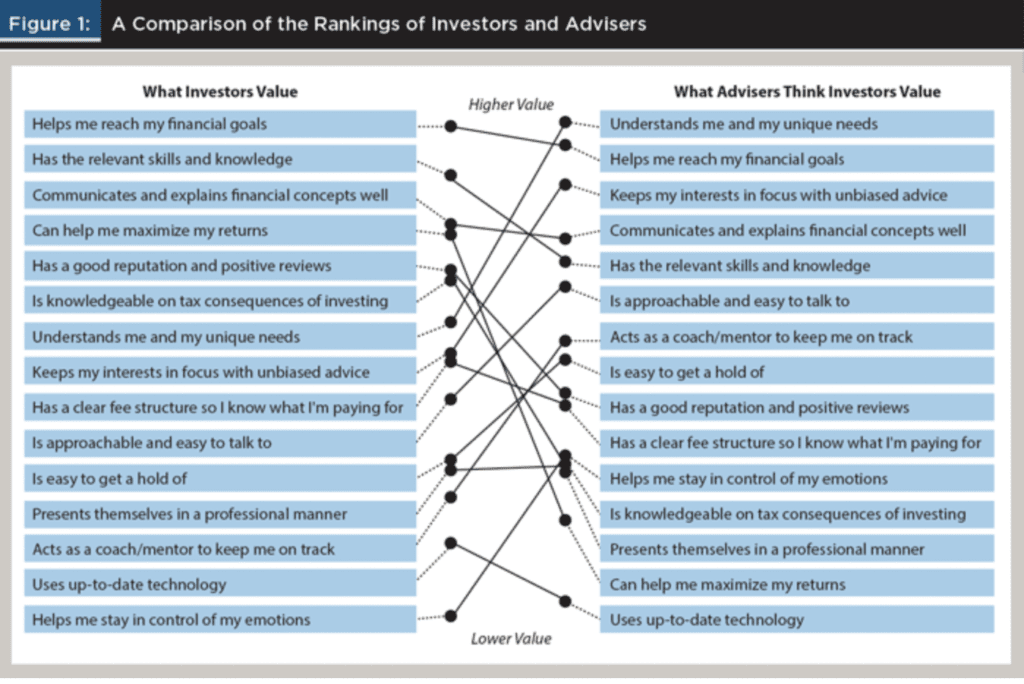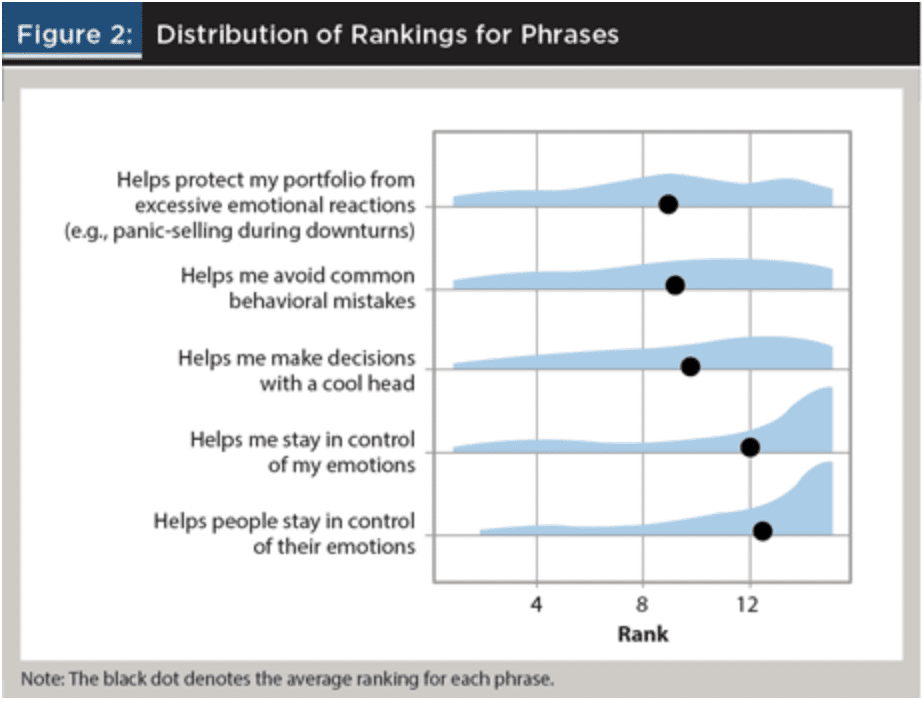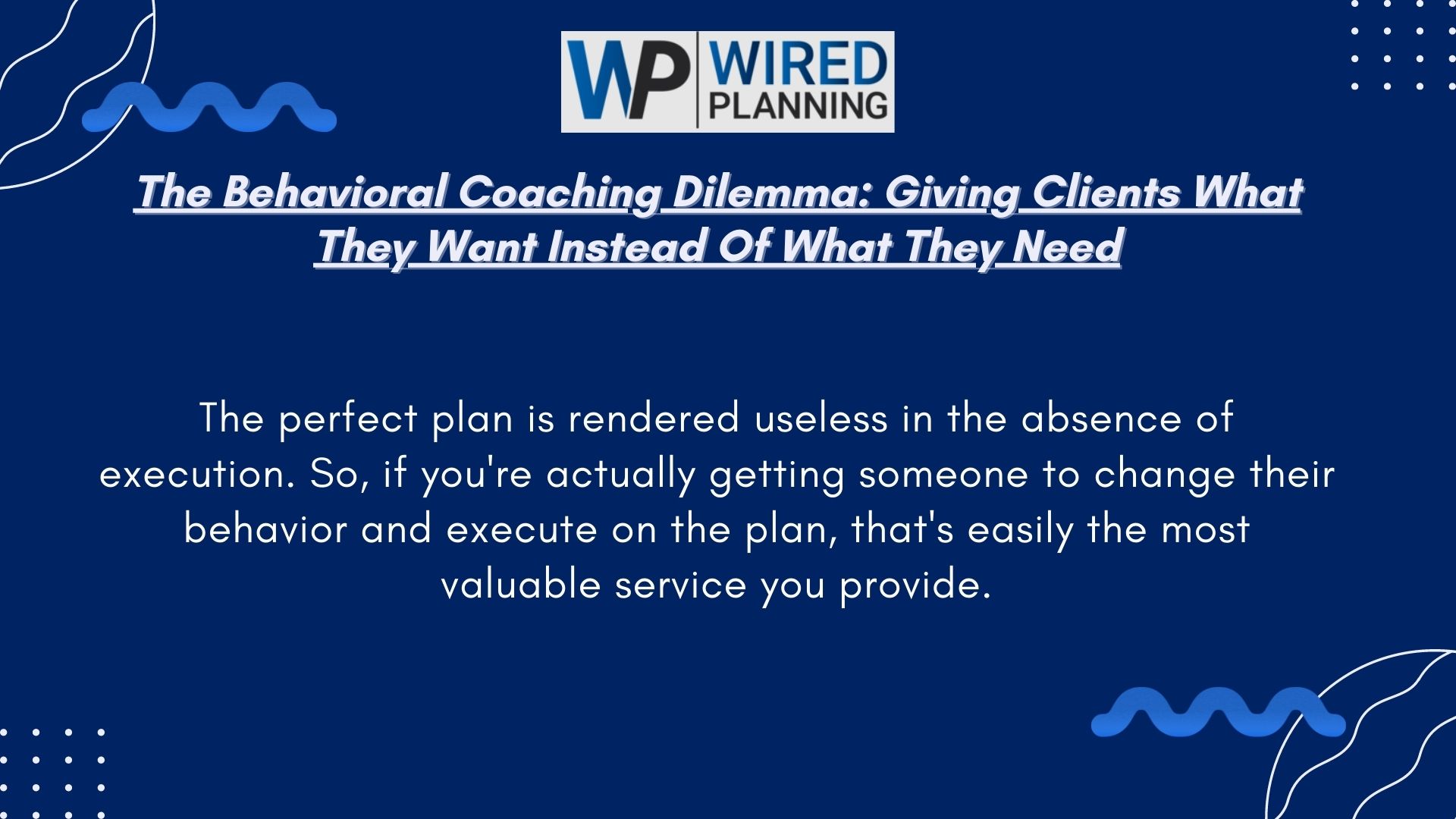Let’s start with a thought experiment.
Can you name a client who went through your entire process from beginning to end completing everything on time without needing a reminder or follow-up?
Someone who didn’t need to be reminded to send in their documents?
Who didn’t need you an email reminder to schedule an estate planning meeting?
Who didn’t need a friendly nudge to follow-through on your advice to start saving an extra $500/month?
Who has nerves of steel and never flinches when their accounts are plummeting because the world around them is collapsing?
It’s about as common as finding a fund manager that can consistently outperform the market.
This is what’s commonly known as the behavior gap (or knowing-doing gap).
Information alone wasn’t sufficient. Simply telling them what to do didn’t yield results.
They needed you and your team to nudge and encourage them to actually execute on the plan.
Quantifying The Value of Behavioral Coaching for Advisors
The increased awareness and interest in behavioral finance has started to shine a light on the fact that behavioral coaching is valuable when working with clients.
In fact, there have been numerous studies conducted with the goal of quantifying the value of an advisor. We’ve had Morningstar’s “Mind The Gap”, Vanguard’s “Advisor Alpha“, and Russel Investment’s “Value Of An Advisor” study.
And in each of these studies, the top “value-add” derived from working with an advisor boils down to the behavioral coaching element. It’s worded differently in each study, but basically, the most valuable thing an advisor does is help clients behave the way they are supposed to.
Naturally, in a profession where value is in the eye of the beholder by means of offering an intangible product, we all want to be able to quantify our value (both for our own validation and the client’s).
Yet, the numbers show that most advisors don’t actively promote this value:
- 83% don’t include information about personal coaching or life planning in promotional or marketing materials
- 72% don’t discuss the role of coach or counselor during an initial contact
But if it’s’ the most valuable component of our work, should we be actively communicating this value to our prospective clients?
“Hey Mr. Client, if you want to retire in 5 years, you’ve come to the right place. We’ll build a plan to get you there and show you how to invest. More importantly, though, I help you do the things you need to do and avoid the things you shouldn’t!”
Think about these dynamics from the vantage point of another industry: personal training.
Ask someone why they want a personal trainer and the first thing they will say is: “I want to lose 20 pounds. And I need someone to show me the workout and nutrition plan to get me there.”
Here is what they won’t say: “I want to go to a personal trainer so that I can actually get out of bed in the morning when my alarm goes off and to make sure I do a few extra reps when I’m tired.”
But ask any personal trainer the value they provide their clients and they’ll tell you it’s accountability and getting people to do the things they don’t want to do on their own.
What Clients Want and What Clients Need
There’s a difference between what people want and what they need.
The personal training client wants someone to help them lose 20 pounds so they have the energy to play with their kids and not feel exhausted.
What they need is someone to help change their behavior and stick to the plan that will get them there.
As an advisor, you know exactly what clients need. But what do clients actually want?
If they want someone to act as a behavioral coach, then you should undoubtedly broadcast to clients that you’re the best behavioral coach around.
Unfortunately, it clearly revealed that financial advice clients see the behavioral elements in the same light as personal training clients.
Two of the fifteen attributes to choose from were of the behavioral variety:
- “Helps me stay in control of my emotions”
- “Acts as a coach/mentor to keep me on track”

As you can see, these two attributes registered as #13 and #15 on the list. (And, according to the researchers at Morningstar, “Helps me stay in control of my emotions” was a distant #15!)
Clients say they want someone to help them achieve their financial goals. We know what they need is someone to change their behavior and actually follow-through with what they need to do.
Incorporating Behavioral Coaching: Give Them What They Want, Slip In What They Need
So how do we reconcile this situation where clients don’t want what they need the most?
We take a page out of the parenting playbook in the chapter titled “How To Get Kids To Eat Their Vegetables.”
Put broccoli on a child’s plate and they won’t touch it. So you have to find ways to slip broccoli in without them noticing. Or, you put spinach in the smoothie.
If you’ve never had a smoothie and added spinach, it’s truly a fascinating experiment. No matter how much spinach you pile into the blender, you simply can’t taste it. But it’s still packed with all of the health benefits and nutrients.
Give them what they want and slip in what they need.
Here are a few practical examples of how you can do that (And, I’m not even going to mention keeping someone from selling when the markets down because it’s the most obvious):
- Form a vivid and crystallized vision of their goals and values. Help bridge the gap between their current and future selves.
- Spend 5 minutes at the end of each meeting asking Moira Somers’s 3 questions to improve follow-through
- Write out and agree to plans that will govern your future actions when you’re in an emotional state
But, here’s the only draw-back to that approach: the benefits are concealed and never made known.
And, in a business/industry where we want to validate and verify the value we provide clients for the fees that they pay, then naturally, you want to make them aware of the ways in which you are providing value (especially when it’s the #1 source of value provided).
So, how can we effectively bring awareness to the fact that massive value is being delivered whether the clients wants it or not?
Three Insights For Effectively Communicating The Value of Behavioral Coaching
There are three things to know about effectively communicating the value of behavioral coaching:
- Evaluate Your Purpose
- Timing Is Everything
- Focus on Framing
Evaluate Your Purpose
Start by asking yourself what you’re trying to accomplish by broadcasting your value as a behavioral coach.
Are you trying to convey the value to prospective clients as a reason to hire you or are you wanting to show existing clients another way you provide value for the fees they’re paying?
Your primary focus when getting a prospective client to hire you should be focusing more on delivering the result they want rather than the value you provide.
As Carl Richards says: “Clients care about their problems not your solutions.”
Which means communicating your services tailored to what clients want and not what they need. And, you’ll probably never have a prospective client walk in saying they want someone to help them manage their behavior.
As for existing clients, if you’re delivering the results they want, then justifying your fees will rarely be an issue.
Back to the personal trainer example for a second. If their client lost 20 pounds and had boundless energy when playing with their kids, do you think they ever complain about fees?
However, if you like to quantify and justify your fees, here are two ways to do it most effectively.
Timing Is Everything
Think about it like the lane control feature on new cars.
If you’re not familiar, when you’re driving on the interstate for example, and the car starts drifting into the other lane while you’re daydreaming about Roth conversion strategies, it simply nudges you back into your own lane.
Or, if you’re coming up too fast on a car in front of you, it will gently slow you down so that you don’t get dangerously close.
People buy cars for a lot of reasons. But, ultimately, one of the primary reasons you buy a car is the ability to get from point A to point B.
And, you can get from point A to point B without lane control. In fact, all lane control does is act as a mechanism to protect you against your own mistakes. Looked at through that lens, lane control isn’t valuable.
Until it is. Until you feel the lane control system pull you back into your lane that you had drifted out of. Or until you feel the brake applied and look up to see you were a lot closer to the car in front of you than you thought.
In that moment, the value of lane control is on full-display. But you can’t fully appreciate and understand the value until you need it.
Behavioral coaching acts the same way. As human beings, we don’t think we need help. Until we do.
Thus, you want to highlight the value of behavioral coaching at the point in time where it’s value is on full display.
For example, when the market drops 40% and you talk the client off the ledge (or all the work you’ve done has prevented them from even getting close to the edge) and then rebounds (much like it did in March of 2020), use that as a tangible example of your value.
Use it as a teaching moment to point out to the client how much better off having made that one decision to stick to the plan you worked on together.
Turn it into a dollar figure. If they had $1,000,000 and it dropped 40%, it would have been $600,000. But they stuck to the plan. They were able to ride the wave back up and it’s now back to $1,000,000. That’s a $400,000 decision.
Regardless of your fee structure, you’ve made them more money than they’ll ever pay you.
Focus On Framing
There’s another crucial element to effectively conveying the value. It was also discovered in the Morningstar study mentioned above where clients identified “Helps me stay in control of my emotions” as the least valuable attribute.
Morningstar conducted a series of follow up surveys with the participants where they switched up the wording of the attribute. As it turns out, the way it was framed made a big difference in how clients perceived the value.

“Helps me stay in control of my emotions” ranked dead last. But “Helps me protect my portfolio from excessive emotional reactions (e.g. panic-selling during downturns)” moved it all the way up to 9th.
The way you frame and deliver the message impacts value perception. It’s hard to see the benefit of someone who keeps my emotions in check. It’s easy to see the value in protecting your portfolio.
No one wants a “behavioral coach.” According to the study, no one wants someone who “helps me stay in control of my emotions.”
But most people understand and embrace “accountability.” They want someone who can “make it easier to do the things they need to do to accomplish their financial goals.”
The Value Of An Advisor Continues To Shift Towards Behavioral Coaching
As the industry continues to evolve and the value of an advisor shifts more towards the ability to guide clients through the process, unearth the values and emotions, and change their behavior for the better, the focus on behavioral coaching will only intensify.
More research studies will be commissioned verifying that behavioral coaching and management is the most valuable service we provide.
But, until clients start asking for someone to change their behavior, it’s best to stay focused on what they want and slip in what you know they need.
Whenever you’re ready, there are 3 ways I can help you master the human side of advice:
- HSOA Masterclass: An 8-week group program on building trust & connection, aligning money and life, and delivering frictionless advice.
- The Ultimate Discovery Meeting: A proven framework to seamlessly convert prospects into life-long clients in one meeting.
- HSOA Community (COMING SOON!): An online space to meet, collaborate, discuss, brainstorm, learn and grow with other advisors passionate about the human side of advice
If you’re interested, let me know here.

